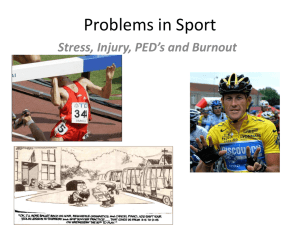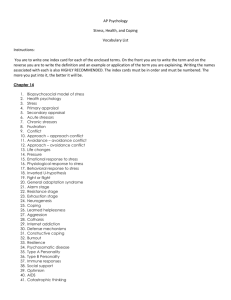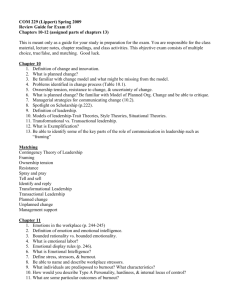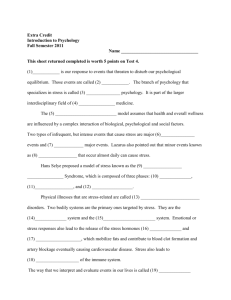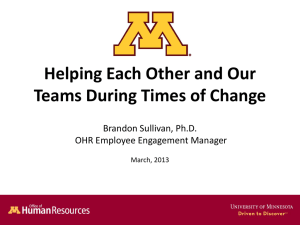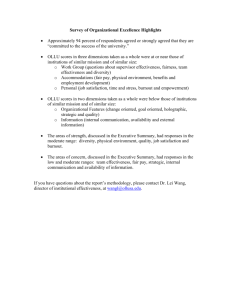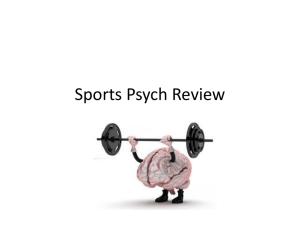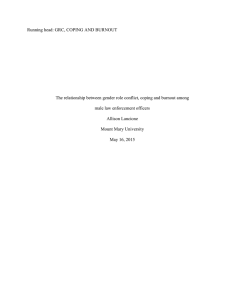Sports Psychology: Problems in Sports Stress and Injury Stress is
advertisement
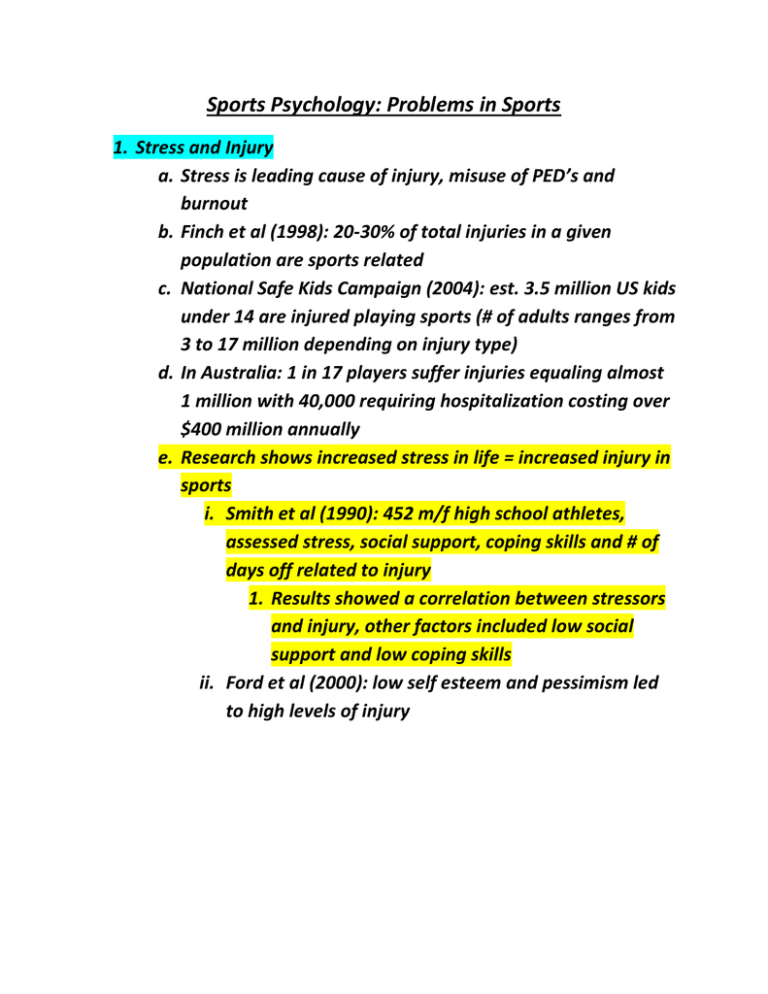
Sports Psychology: Problems in Sports 1. Stress and Injury a. Stress is leading cause of injury, misuse of PED’s and burnout b. Finch et al (1998): 20-30% of total injuries in a given population are sports related c. National Safe Kids Campaign (2004): est. 3.5 million US kids under 14 are injured playing sports (# of adults ranges from 3 to 17 million depending on injury type) d. In Australia: 1 in 17 players suffer injuries equaling almost 1 million with 40,000 requiring hospitalization costing over $400 million annually e. Research shows increased stress in life = increased injury in sports i. Smith et al (1990): 452 m/f high school athletes, assessed stress, social support, coping skills and # of days off related to injury 1. Results showed a correlation between stressors and injury, other factors included low social support and low coping skills ii. Ford et al (2000): low self esteem and pessimism led to high levels of injury f. How can we explain this relationship between stress and injury? i. Williams et al (1991); stress disrupts attention, reduces peripheral awareness ii. Anderson & Williams (1999): negative life event stressors were the only significant predictor of injury in 196 college athletes iii. Smith et al (2000): muscle tension caused by stress interferes with normal coordination, thus increasing rick of injury iv. Stress can impact recovery 1. Cramer et al (2000): natural healing disrupted by high glucocorticoids, impairing the immune response and inhibiting production of growth hormones 2. Perna et al (2003): stress caused impaired sleep patterns and protein synthesis-essential for recovery process g. Athlete response to injury i. Coping with 3 stressors (Physical, Psychological and Social) essential to rehab process takes one of 2 forms 1. Grief Response Model (Hardy, Crace 1990) a. See Kubler-Ross (1969) grieving process i. Denial: injured players pushes it and make it worse ii. Anger: about injury’s impact on ability/career iii. Bargaining: deal making to mitigate the injury iv. Depression: reality of injury v. Acceptance/reorganization: coping can begin b. Criticisms: not empirical, anecdotal, steps not always followed in order (Brewer, 1994), no evidence of denial or bargaining (Urdy et al, 1997) c. Petitpas & Danish (1995): Identity Loss— injury low self – efficacydepressionlow self confidencelow status and motivationidentity loss 2. Cognitive Appraisal Model (Urdy et al, 1997) a. Stages of “Information Processing” about injury i. Stage 1: Amount/type of pain, how/why it happened, consequences and rehab options ii. Stage 2: emotional upheaval, reactive behaviors—anger, frustration 1. Can be a relief from performance pressures (Wiese, Bjornstal et al, 1995) or cause for depression (10 to 20%, Brewer, 1995) iii. Stage 3: Developing, outlook and coping b. “Cognitive Appraisal” (Wiese, Bjornstal, 1998) i. Primary: what is at stake, challenge, threat, benefit or loss ii. Secondary: how can you cope, options available Diagram of the Wiese-Bjornstal Model Dispositional Factors Situational Factors --Injury History --Time in season --Personality --Status --Motivational Orientation --Social support --Athletic Identity --Coach’s influence Cognitive Appraisal --Goal adjustment --Self perception --Sense of loss/grief --Cognitive coping Behavioral Response Emotion Response --Risky behavior --Anxiety/fear --Malingering --Frustration --Commitment to rehab --Depression --Behavioral coping --Positive outlook 2. Why has there been an increase in PED use during the last 20 years? a. Physical considerations i. Strength, endurance, alertness, aggression, fatigue, anxiety, wt. gain/loss all can be impacted by PED’s b. Psychological considerations i. Coping w/stress, self esteem, confidence, respond to external pressures c. Social considerations i. Social learning theory: see model (Bonds, Canseco, Ben Johnson) do it without getting caught (Bandura; Anshel, 1998) ii. Conformity, coercion, peer pressure iii. “Game Theory” (Axelrod, 1984): if you don’t use you will be left behind by the using competition (e.g. EPO doping in the Tour de France, roids in MLB), leads to cognitive rationalization that the rewards outweigh the risks of getting caught 3. Effects of drug use in sports a. Physical: Steroids i. synthetic derivatives of testosterone, anabolic effects retention of protein to build muscle ii. “stacking”: combo of different types can be permanent iii. Injections increase risk of Hepatitis B, HIV iv. Damage may take years to see (Lyle Alzado) v. Feminization Effect in men: decrease in male sex function, low sperm count, impotence, development of breasts, shrinking testicles, pain w/urination vi. Women have “Masculinization Effect” (see East German Olympians) vii. Acne, wt. gain, liver damage, heart attack, stroke, increased cholesterol, weak tendons (see Bo Carrol), permanent growth halt in teens in both males and females b. Psychological: Steroids i. Mood swings, extreme irritability/aggression (“roid rage”), addiction and withdrawal issues c. Other PED’s and their effects i. Beta blockers: reduce anxiety, blood pressure, heart rate, depresses CNS ii. Diuretics: wt. loss, dehydration, cramping, kidney stones, increased cholesterol iii. EPO: increased oxygen and stamina, risks for blood clots, heart attack, stroke iv. Narcotics: mask pain, failure to feel injury, overdose threat 4. Causes of Burnout a. Def: the physical, emotional, psychological withdrawal from formerly enjoyable activity due to stress or dissatisfaction b. Cognitive-Affective Stress Model (Smith 1986) how thoughts and feelings influence athlete’s burnout i. Stage 1: Situation Demands: demands exceed resources = stress ii. Stage 2: Cognitive Appraisal: threat vs. challenge appraisal of situation = anxious or excited iii. Stage 3: Physiological Responses: fight or flight due to appraisal iv. Stage 4: Behavioral Response: performance issues, cohesion problems, withdrawal c. Hardiness (Kobasa, 1986) is the key factor to overcoming stressors and resisting burnout; based on 3 factors i. Control: person’s ability to influence events ii. Commitment: person’s refusal to give up iii. Challenge: person’s willingness to change d. Mental Toughness Model (Clough and Earle, 2001) i. Mental toughness questionnaire resulted in a group of mentally tough subjects and non mentally tough who then did 3 30 minute cycling trials at 30, 50 and 70% max; oxygen uptake and reactions of subjects was recorded ii. Results showed MT subjects reported lower perceived exertion, even at 70% suggesting MT helps withstand stress/burnout e. Self Determination Theory (Raedeke, 1997) i. Burnout results from lack of intrinsic motivation or control over participation; “have to” rather than “get to” attitude ii. Factors include: identity = sport, entrapment, social support/demands 5. Measuring Burnout a. Gould et al 1996-7: 2 strains of burnout i. Dominant Strain: situational, environmental factors ii. Physically Driven Strain: can’t meet demands of sport b. Maslach Burnout Inventory: test based on 3 scales i. Emotional Exhaustion ii. Depersonalization iii. Sense of Personal Accomplishment 6. Preventing Burnout a. 2002 (Raedeke) semi structured interviews of swim coaches identified 7 signs of burnout i. Withdrawal from team ii. Decreased sense of accomplishment iii. Diminished sense of progress iv. Devaluation of sport v. Exhaustion: physical, mental, emotional vi. Pressure: internal or external vii. Loss of control/balance of sport/outside life 1. Prevention strategies revolved around the following: a. Identification by teammates/coaches early b. Support/structure from team/coach/family c. Coach’s empathy, recognition and support i. Supportive, cooperative culture ii. Flexibility, fun, exciting training iii. Set realistic yet challenging goals, task oriented b. Cognitive Affective Stress Management (Smith, 1980) i. Mental/physical coping strategies designed to prevent burnout in 4 steps 1. Pre-treatment Assessment: interviews to assess the athlete’s stress response and appraisal 2. Treatment Rationale: athlete analyzes and gains understanding of personal stress reactions 3. Skill Acquisition: athlete learns relaxation, cognitive restructuring and self talk 4. Skill Rehearsal: stress is induced to allow athlete to practice new stress reducing skills c. Stress Inoculation Theory (SIT) Meichenbaum, 1985 i. Athlete is exposed to increasing levels of stress in 3 stages, thereby enhancing his/her immunity “Learned Resourcefulness” 1. Stage 1: Conceptualization: athlete becomes aware of +/-- thoughts, self talk, imagery 2. Stage 2: Rehearsal: practice 3. Stage 3: Application: athlete encounters low stress and then moves up to moderate then high and applies what was rehearsed in stage 2 4. Prepare--control--cope--evaluate--overcome
